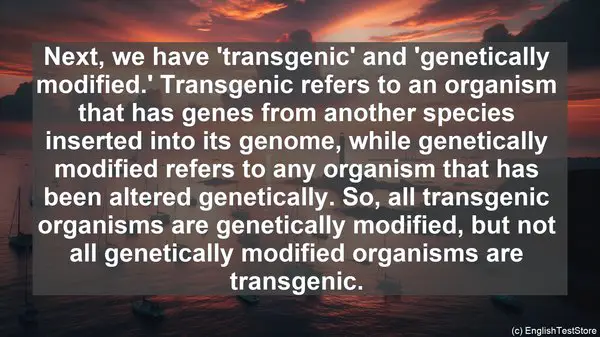Introduction
Welcome to today’s lesson. In the world of biotechnology, there are several terms that often get mixed up. These words may sound similar or have overlapping meanings, but they are distinct and important to understand. Today, we’ll be discussing the top 10 commonly confused words in biotechnology.
1. Gene vs. Genome
Starting off, we have ‘gene’ and ‘genome.’ While both are related to genetics, they refer to different things. A gene is a specific sequence of DNA that codes for a particular trait, while a genome is the complete set of genetic material in an organism. So, think of a gene as a single piece of the puzzle, and the genome as the entire picture.

2. Cloning vs. Genetic Engineering
Next up, ‘cloning’ and ‘genetic engineering.’ These terms often create confusion. Cloning is the process of creating an identical copy of an organism, while genetic engineering involves modifying an organism’s DNA to introduce new traits. So, cloning is like making a photocopy, while genetic engineering is like editing the content of a document.
3. Recombinant DNA vs. Synthetic DNA
Moving on, we have ‘recombinant DNA’ and ‘synthetic DNA.’ Recombinant DNA is created by combining DNA from different sources, while synthetic DNA is artificially created in a lab. Recombinant DNA is like a jigsaw puzzle made from different pieces, while synthetic DNA is like a puzzle you create from scratch.

4. Bioreactor vs. Fermenter
Now, let’s talk about ‘bioreactor’ and ‘fermenter.’ These terms are often used interchangeably, but they have slight differences. A bioreactor is a vessel used for a wide range of biological processes, while a fermenter is specifically used for fermentation, a process where microorganisms convert substances into useful products. So, a fermenter is a type of bioreactor, but not all bioreactors are fermenters.
5. Transgenic vs. Genetically Modified
Next, we have ‘transgenic’ and ‘genetically modified.’ Transgenic refers to an organism that has genes from another species inserted into its genome, while genetically modified refers to any organism that has been altered genetically. So, all transgenic organisms are genetically modified, but not all genetically modified organisms are transgenic.
6. Antibiotic vs. Antimicrobial
Moving on, ‘antibiotic’ and ‘antimicrobial.’ Though often used interchangeably, they have different meanings. Antibiotics are substances that specifically target and kill bacteria, while antimicrobials refer to a broader range of substances that can kill or inhibit the growth of microorganisms, including bacteria, viruses, and fungi.
7. In Vivo vs. In Vitro
Now, let’s discuss ‘in vivo’ and ‘in vitro.’ In vivo refers to experiments or processes that are conducted within a living organism, while in vitro refers to those conducted outside of a living organism, typically in a lab setting. So, in vivo is like studying a plant in its natural habitat, while in vitro is like studying it in a controlled greenhouse environment.
8. Bioprocessing vs. Biomanufacturing
Next up, ‘bioprocessing’ and ‘biomanufacturing.’ While they are related, they have different scopes. Bioprocessing refers to the use of biological materials or processes to produce a desired product, while biomanufacturing is the large-scale production of biological products using bioprocessing techniques. So, bioprocessing is like making a small batch of homemade cookies, while biomanufacturing is like producing thousands of cookies in a factory.
9. Bioinformatics vs. Computational Biology
Moving on, ‘bioinformatics’ and ‘computational biology.’ These terms are often used interchangeably, but they have distinct focuses. Bioinformatics involves the analysis and interpretation of biological data using computational tools, while computational biology is a broader field that uses computational methods to study biological systems. So, bioinformatics is like analyzing a specific dataset, while computational biology is like developing new algorithms to study biological processes.
10. Biosafety vs. Biosecurity
Lastly, let’s differentiate ‘biosafety’ and ‘biosecurity.’ Biosafety refers to the measures taken to protect individuals and the environment from potential hazards in a laboratory or research setting, while biosecurity involves measures to prevent the unauthorized access, loss, theft, or intentional misuse of biological materials or information. So, biosafety is like wearing protective gear in a lab, while biosecurity is like having secure access controls and protocols in place.
